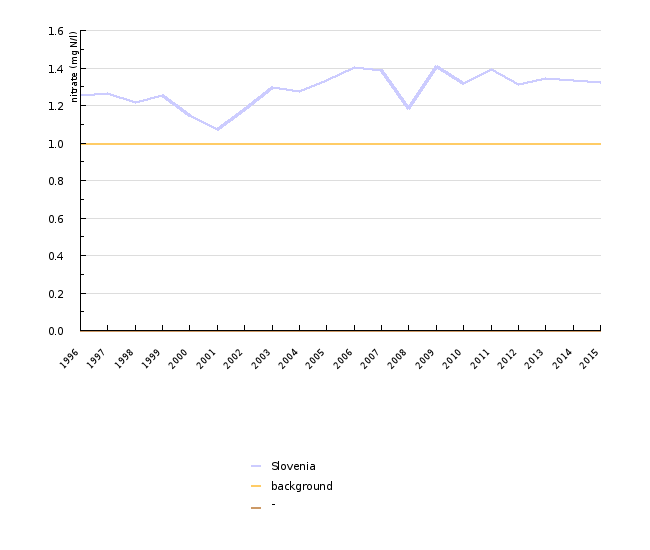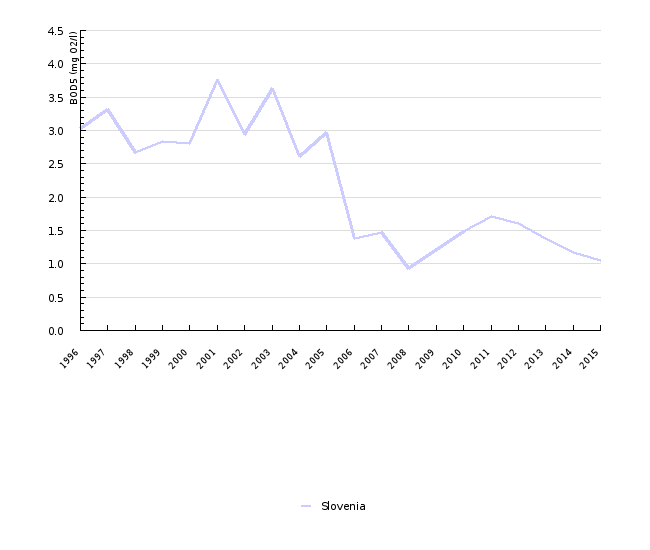[VD10] Nutrients in rivers

Key message

Average levels of nitrate and orthophosphate in rivers are above the natural background values and do not show significant changes in the observed period. Average values of biochemical oxygen demand and ammonium concentration in rivers in the observed period have been decreasing. The decrease is in accordance with the increase in the percentage of the population connected to municipal and common wastewater treatment plants.
Definition
This indicator shows human-induced eutrophication of rivers with nutrients and pollution of rivers with organic substances. Nutrients are presented as the content of nitrate and ortophosphate, while organic load is presented by biochemical oxygen demand and ammonia. The data is based on measurements that were carried out on water samples taken in the course of regular monitoring of the quality of surface waters.
Nitrate and ortophosphate are the main nutrients required for the growth of algae, mosses and water plants in rivers. In non-polluted waters they are present in very low concentrations that mostly depend on geological properties and soil types in the catchment area (natural background). The values of nitrate and ortophosphate in water that exceed the natural background are a result of human activities, mainly agriculture and urban/industrial wastewater discharge. Excess nutrients in watercourses lead to eutrophication and, consequently, hypoxia, reduced biodiversity and disruptions in the normal functioning of an ecosystem. Also, high nitrate content may compromise the quality of drinking water. Water is no longer suitable for drinking when nitrate concentration exceeds 10 mg NO3-N/l (50 mg NO3/l).
Biochemical oxygen demand (BOD) and ammonia are the main indicators of organic water pollution. The values of both parameters are usually elevated as a result of urban and industrial wastewater discharge and leaching of nutrients from agricultural land. The BOD is the amount (in mg O2/l) of dissolved oxygen needed (i.e. demanded) by aerobic biological organisms to break down organic material present in a given water sample at a certain temperature over a specific time period. It is usually expressed as BOD5, which means milligrams of oxygen consumed per litre of sample over 5 days of incubation at 20°C. In a water environment, ammonia represents an increased demand for oxygen. In the nitrification process, ammonia is converted (through oxidation) to nitrite and then to nitrate, thus contributing to the eutrophication process. In small quantities, nitrite is toxic to water organisms. This also holds for ammonium, which is derived from ammonia under certain conditions (a combination of water temperature, salinity and pH-value). Ammonia represents a risk for drinking water sources as well.
Charts
Standardised Database for Water Quality Monitoring, Slovenian Environmental Agency, 2015
| 1996 | 1997 | 1998 | 1999 | 2000 | 2001 | 2002 | 2003 | 2004 | 2005 | ||
|---|---|---|---|---|---|---|---|---|---|---|---|
| Slovenia | mg N/l | 1.25 | 1.26 | 1.22 | 1.25 | 1.14 | 1.07 | 1.18 | 1.3 | 1.28 | 1.33 |
| 2006 | 2007 | 2008 | 2009 | 2010 | 2011 | 2012 | 2013 | 2014 | 2015 | ||
| Slovenia | mg N/l | 1.4 | 1.39 | 1.18 | 1.41 | 1.32 | 1.39 | 1.31 | 1.35 | 1.33 | 1.32 |
Standardised Database for Water Quality Monitoring, Slovenian Environmental Agency, 2015
| 1998 | 1999 | 2000 | 2001 | 2002 | 2003 | 2004 | 2005 | 2006 | 2007 | ||
|---|---|---|---|---|---|---|---|---|---|---|---|
| orthophosphate | mg P/l | 0.059 | 0.048 | 0.057 | 0.055 | 0.047 | 0.068 | 0.047 | 0.045 | 0.054 | 0.07 |
| 2008 | 2009 | 2010 | 2011 | 2012 | 2013 | 2014 | 2015 | ||||
| orthophosphate | mg P/l | 0.031 | 0.034 | 0.049 | 0.049 | 0.055 | 0.053 | 0.041 | 0.033 |
Standardised Database for Water Quality Monitoring, Slovenian Environmental Agency, 2015
| 1998 | 1999 | 2000 | 2001 | 2002 | 2003 | 2004 | 2005 | 2006 | 2007 | ||
|---|---|---|---|---|---|---|---|---|---|---|---|
| Slovenia | mg N/l | 0.355 | 0.192 | 0.263 | 0.216 | 0.245 | 0.332 | 0.206 | 0.188 | 0.187 | 0.234 |
| 2008 | 2009 | 2010 | 2011 | 2012 | 2013 | 2014 | 2015 | ||||
| Slovenia | mg N/l | 0.095 | 0.181 | 0.166 | 0.282 | 0.23 | 0.204 | 0.11 | 0.039 |
Standardised Database for Water Quality Monitoring, Slovenian Environmental Agency, 2015
| 1996 | 1997 | 1998 | 1999 | 2000 | 2001 | 2002 | 2003 | 2004 | 2005 | ||
|---|---|---|---|---|---|---|---|---|---|---|---|
| Slovenia | mg O2/l | 3.03 | 3.32 | 2.67 | 2.84 | 2.81 | 3.76 | 2.94 | 3.62 | 2.61 | 2.97 |
| 2006 | 2007 | 2008 | 2009 | 2010 | 2011 | 2012 | 2013 | 2014 | 2015 | ||
| Slovenia | mg O2/l | 1.38 | 1.47 | 0.93 | 1.22 | 1.48 | 1.71 | 1.61 | 1.37 | 1.17 | 1.05 |
Goals
· the goals of the Water Framework Directive (Directive 2000/60/ES) on preservation and improvement of the water environment;
· the goals of the Nitrates Directive (91/676/EEC) on reduction and prevention of water pollution by nitrates from agriculture;
· the goals of the Directive on urban wastewater treatment (91/271/EEC) for protection of the environment against harmful impacts of wastewater discharge;
· the goals of the Directive on the quality of water intended for human consumption (98/83/EC) and the Directive concerning the quality required of surface water intended for the abstraction of drinking water in the Member States (75/440/EEC) where nitrate content in drinking water is limited
· the goals stated in other regulations in the field of protection and use of water.
Comment
Nitrate concentrations in the observation period were only slightly above the natural background values, which range between 0.2 and 0.9 mg N/l in Slovenian watercourses depending on their ecological type. There are no notable differences between annual values, while long-term decreasing or increasing trends have not been observed. Ortophosphate concentrations in the observation period were considerably above the natural background values, which range between 2 and 8 µg P/l in Slovenian watercourses depending on their ecological type. Inter-annual values can differ markedly as well. A slight decrease in ortophosphate values has been observed, but cannot be statistically confirmed. Nevertheless, the average ortophosphate value in the period 2008–2015 is 12 µg P/l lower than in the period 1998–2007.
The loading of waters with nitrogen and phosphorous is mostly a consequence of leaching from agricultural land and, to a lesser extent, urban and industrial wastewater discharge. Although the area of agricultural land has increased slightly since 2002 (see indicator KM10: Land use change and agriculture), consumption of mineral fertilisers has been decreasing throughout the observation period (see indicator KM02: Consumption of mineral fertilisers). This is probably why a moderate decrease in nutrient levels (mostly phosphorous) in rivers has been observed.
In the observation period, the organic load of rivers decreased considerably. Particularly noticeable is the decrease in BOD5 values from 2006 onwards, when they occasionally approached the levels of the natural background, which ranges between <1 and 1.4 mg O2/l in most Slovenian watercourses.
Urban wastewater is the main source of pollution with organic substances. As the situation in the field of wastewater discharge and treatment has been improving in Slovenia for several years, changes in the parameters of organic load have been expected. The indicator VD02: Wastewater treatment shows that the share of the population connected to urban and combined wastewater treatment plants is considerably higher today than it was in 2004. The percentage of secondary (biological) wastewater treatment, which removes the majority of organic substances and some nutrients, is also much higher today than it was in 2004.












